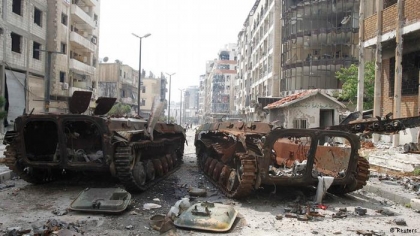Syria before the War

Since 2011 Syria experienced one of the most devastating conflicts in recent history. More than 250,000 lives were lost and also the damage to the infrastructure of Syria is horrible. In 2015 Syria received the last place in the list of all countries on the Global Peace Index. But how was Syria before the war?
Syria is often described as the cradle of civilization. Civilization began in Syria around 9000 BC and the first human settlements developed on this ancient land. With the creation of early agriculture, mankind was able to abandon its hunter-gatherer lifestyle and evolve into the modern man. In the coming millennia Syria witnessed the rise and fall of the Assyrian empire and the birth of the three big monotheistic religions. These were events that influenced not only the past but also influence present day Syria.
Before the war there were no ethnic or religious divisions within Syria. Christians, Muslims and Jews co-existed together as Syrians. Nobody was asking if you are Sunni, Shiite, Alawite or maybe a Druze. Muslims went to the mosque for the Friday prayers, while next to the mosque on the opposite side of the street there was a Christian monastery. It was no contradiction for the Syrian president, coming from an Alawite family, to marry his wife Asma al-Assad, who came from a Sunni family. Despite this, nowadays the western media still tries to speak about the Syrian government as “Bashar al-Assad’s Alawite sect.” In reality, these fractions amongst religions never existed in the pre-war Syria
Before the war, Syrian society was warm and welcoming to everybody. A Syrian friend of mine described the Syrian pre-war society very well with a story he told me. He has been living in Europe for some decades already but visits his motherland every year to see his family, friends or even to have a nice vacation. He comes from a Sunni family but has never been very religious.
Once he visited Syria with his Christian wife from Europe. She was especially interested in the Christian cultural heritage of the country. So they decided to visit the ancient settlement of Maaloula near Damascus. Maaloula is a beautiful city of only a few thousand inhabitants. It is built into the rugged mountainside and is famous because it is one of the handfuls of villages where Aramaic, the language of Jesus Christ, is still spoken today. There had been 32 churches in the city when my friend and his wife visited it. Some of the churches in Maaloula are the oldest churches in existence. Nowadays most of them have been damaged and destroyed by “rebels” of the Al-Nusra Front (al-Qaeda in Syria) in 2013. But at the time, when they visited the village, these churches were still standing. During their way to the small village they passed many other villages by car. On their way, they got out of the car and walked around the streets of one of the smaller settlements. Suddenly some of the villagers came towards them. They offered the couple gift baskets with regional fruits that they had harvested themselves and asked them if they would like to stay in the village so that they can show them around. Even my friend, who is Syrian, and his wife, were very astonished by the hospitality of the Syrian people. And when they told the villagers that they had to continue their travel the villagers had tears in their eyes and did not want them to go.
This is not the only story about Syrian hospitality. Now it may be hard to believe for somebody who only knows Syria from the pictures of war and destruction on TV. Syria can hardly be recognized when comparing photos before 2011 and today.
Unlike a decade ago when my friend visited the village, Maaloula is now destroyed, the great bazar Al-Madina Souq in Aleppo was burned and destroyed, as well as the Umayyad Mosque in Aleppo and many other places of cultural heritage. All this is thanks to Western support for “moderate rebels,” who are in fact pseudo-Islamic extremists. The church of Saint Paul is in Damascus but has not been destroyed since Damascus is under the control of the Syrian Arab Army (termed by the Western media as “Assad’s army,” it is composed of Christians and Muslims, with many Christians serving as generals). The “Islamic State” is now selling Syrian history on the black market, making up to 100 million US dollars a year. Or just blowing up as idols, as they did with the Baal temple, located in the Syrian city of Palmyra. Even more disturbing is the fact that it will take years to rebuild the homes of the Syrian people and to finish the reconciliation process in Syrian society.
This could have all been prevented if the West didn`t start to arm the jihadist rebels in 2011. If this didn’t happen the conflict in Syria would have been over within a few months and today, we wouldn’t be discussing Syria as a war-torn country over and over again. Instead, we would have seen Syria as an oasis of peace and co-existence between different religions and cultures. A country with a rich history, a beautiful landscape and friendly people. And our only discussions about Syria would have been about our last holidays in the country, our lovely time at the bazaar of Aleppo, in the monasteries of Maaloula and by the Mediterranean sea at Lattakia.
Our team at GIA would like to express sincere gratitude to young men and women who care about the future of their country https://www.facebook.com/shababeeksouria.
Source:
https://gianalytics.org/446-syria-before-the-war
